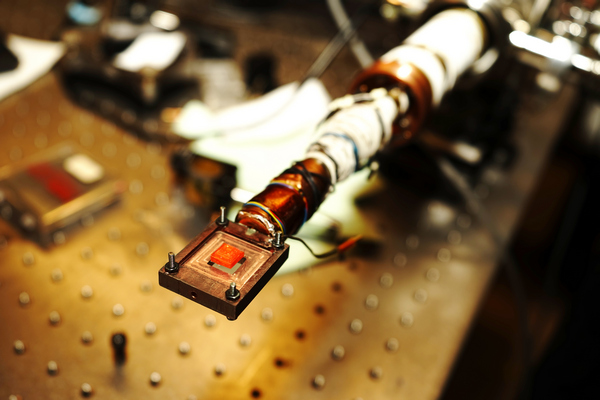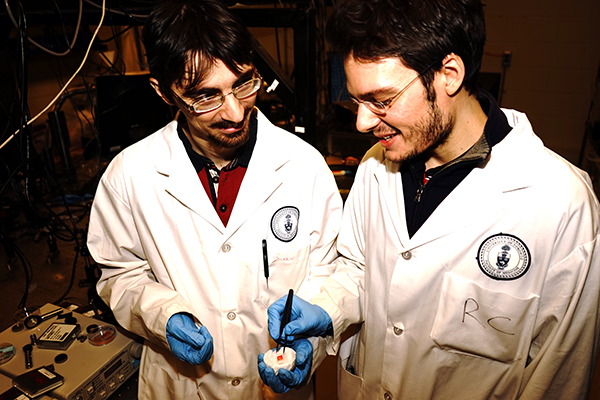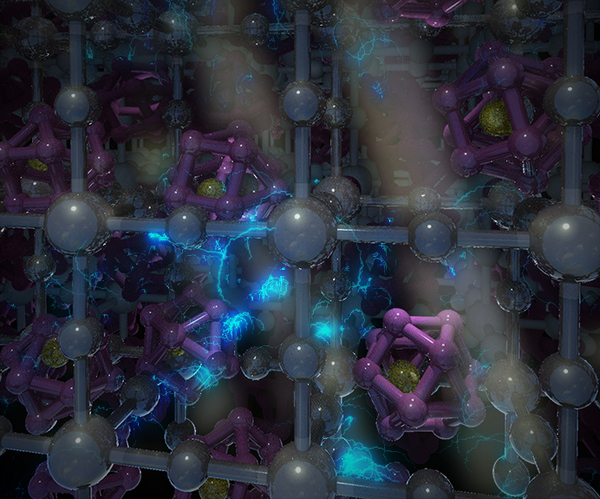Engineers have shone new light on an emerging family of solar-absorbing materials that could clear the way for cheaper and more efficient solar panels and LEDs.
The materials, called perovskites, are particularly good at absorbing visible light, but had never been thoroughly studied in their purest form: as perfect single crystals.
Using a new technique, researchers grew large, pure perovskite crystals and studied how electrons move through the material as light is converted to electricity.
 |
|
A pure perovskite crystal, orange in colour, is mounted on a cryostat. (All photos courtesy of University of Toronto Engineering Department)
|
Led by Professor Ted Sargent of The Edward S. Rogers Sr. Department of Electrical & Computer Engineering at the University of Toronto and Professor Osman Bakr of the King Abdullah University of Science and Technology (KAUST), the team used a combination of laser-based techniques to measure selected properties of the perovskite crystals. By tracking down the rapid motion of electrons in the material, they have been able to determine the diffusion length—how far electrons can travel without getting trapped by imperfections in the material—as well as mobility—how fast the electrons can move through the material. Their work was published this week in the journalScience.
“Our work identifies the bar for the ultimate solar energy-harvesting potential of perovskites,” says Riccardo Comin, a post-doctoral fellow with the Sargent Group. “With these materials it’s been a race to try to get record efficiencies, and our results indicate that progress is slated to continue without slowing down…”
In recent years, perovskite efficiency has soared to certified efficiencies of just over 20 per cent, beginning to approach the present-day performance of commercial-grade silicon-based solar panels mounted in Spanish deserts and on Californian roofs.
“In their efficiency, perovskites are closely approaching conventional materials that have already been commercialized,” says Valerio Adinolfi, a PhD candidate in the Sargent Group and co-first author on the paper. “They have the potential to offer further progress on reducing the cost of solar electricity in light of their convenient manufacturability from a liquid chemical precursor.”
 |
|
Researchers Valerio Adinolfi (left) and Riccardo Comin examine a perovskite crystal. Perovskites are attracting growing interest in the context of thin-film solar technologies, but had never been studied in their purest form: as perfect single crystals. |
The study has obvious implications for green energy, but may also enable innovations in lighting. Think of a solar panel made of perovskite crystals as a fancy slab of glass: light hits the crystal surface and gets absorbed, exciting electrons in the material. Those electrons travel easily through the crystal to electrical contacts on its underside, where they are collected in the form of electric current. Now imagine the sequence in reverse—power the slab with electricity, inject electrons, and release energy as light. A more efficient electricity-to-light conversion means perovskites could open new frontiers for energy-efficient LEDs.
Parallel work in the Sargent Group focuses on improving nano-engineered solar-absorbing particles called colloidal quantum dots. “Perovskites are great visible-light harvesters, and quantum dots are great for infrared,” says Professor Sargent. “The materials are highly complementary in solar energy harvesting in view of the sun’s broad visible and infrared power spectrum.”
“In future, we will explore the opportunities for stacking together complementary absorbent materials,” says Dr. Comin. “There are very promising prospects for combining perovskite work and quantum dot work for further boosting the efficiency.”
 |
|
An artist’s rendering of the atomic model of organolead trihalide perovskite crystals. Researchers have succeeded in growing high-quality single crystals of these perovskites at room temperature. The grown crystals efficiently convert light into charge-carriers that travel over very long distances, exceeding 10 micrometers, due to the crystalsπ exceptionally low concentration of defect trap-states. This study demonstrates that photovoltaics using organolead trihalide perovskite materials stand to see further breakthroughs through substantial improvement in material purity; it also suggests new avenues to deploy perovskites in an even wider range of semiconductor and optoelectronic device. |














